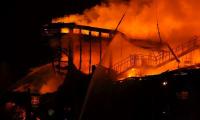Islamabad : The National Commission for Human Development has formulated the National Plan of Action under the Federal Ministry of Education and Technical Training to ensure 90 per cent literacy rate in the country.
"This NPA envisages that the provincial authorities will use the plans to transform policy decisions into action at the ground level," NCHD chairperson Razina Alam Khan told a meeting of the commission's senior management here on Tuesday.
The NCHD chairperson said the commission had established the National Training Institute to ensure quality education in its feeder schools and adult literacy programme along with other projects.
"The NTI will build capacity of the professionals working in the field of literacy and non-formal education. It will also prepare Accelerated Learning Modules and condensed syllabus that would provide OOSC a second chance to take part in educational activities," she said.
Razina Alam said education was the best remedy to all the problems prevailing in the form of extremism, poverty, inequality and social injustice in the society.
"We can only overcome country's socio-economic problems when we have a literate society along with skill development," she said.
The NCHD chairperson stressed the need for devising policies to address the causes for illiteracy such as social inequality, gender disparities, ethnic and linguistic disadvantages and gaps among geographic areas.
She said the country has 207 million population and ironically, one fourth or 22.6 million children of 5-9 age groups were still out of school and 40 per cent of adult population were illiterate and thus, hampering national development and progress.
"Providing an equal education opportunity in the remote areas is the basic right of all the citizens of the country," she said.
She said providing free and compulsory education to the poorest which was engrained with good quality would make sense, while flexible approaches towards learning and multi-grade teaching through non-formal education in remote areas could cut the cost to the lowest and most effective in the under-developed countries.
"The NCHD has adopted a two pronged approach to address the issues of illiteracy in the country, adult literacy for age group 14 and above and primary education both formal education for age group 5-9 and non-Formal education for age group 10-14 to achieve 90 per cent literacy rate in the country," she said.
Razina Alam said the NCHD had made 3.96 million people literate since its inception and providing education to 335,164 children in 5,949 feeder schools in the remote areas to the marginalised group.
She said the NCHD had exercised a number of innovative approaches to reach the marginalized group.
"We are working in jails with the aim to provide education to the convicts and make them useful citizens. We've approached learners in seminaries with reforms and introduced primary education along with religious education in order to bring them in the mainstream of higher education," she said.
Razina Alam said currently, the NCHD was successfully working in 100 Seminaries of former Federally Administered Tribal Areas, Azad Jammu and Kashmir, Gilgit Baltistan and Islamabad Capital Territory.
She said in collaboration with Japan International Cooperation Agency, the commission had launched a model of non-formal school system where 20 schools were functional for children of age 10-14 who could be admitted neither to the primary school nor to adult literacy centres.
Muslims attend the Eid prayer at a mosque in Rawalpindi, Pakistan September 2, 2017. —ReutersISLAMABAD: Following...
A jeweller waits for a customers at a shop on June 26, 2024. — AFPRawalpindi : The employee of a jewellery shop has...
Well-known poet Akhtar Raza Saleemi seen in this image. — Facebook@Akhtar Raza Saleemi/FileAkhtar Raza Saleemi is...
Beggars ask for alms outside a mosque in Pakistan. — Reuters/FileIslamabad : Islamabad’s district administration...
Families busy shopping on Chaand Raat in preparation for Eid ul Fitr at local market on March 30, 2025. —...
Vendors are selling vegetables at a market on March 26, 2023. — OnlineRawalpindi : The prices of essential food...







